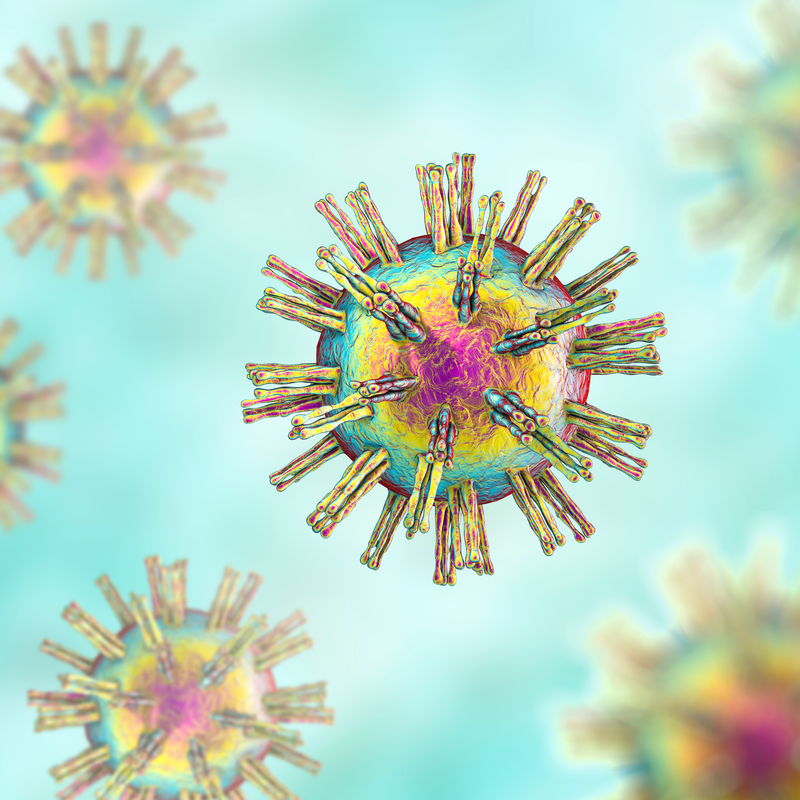
What is Herpes Simplex Virus 2 (HHV-2)?
The herpes simplex virus virus type 2 belongs to the herpes virus family and is a so-called DNA virus. It is mainly responsible for the development of genital herpes . It causes itchy and burning blisters in the area of the genitals.
What is the morphology of herpes simplex virus 2 (HHV-2)?
The genome of the virus consists of a linear double-stranded DNA. It has a size of about 152 kB and is located in a capsid, which is icosahedral and consists of 162 capsomeres. The herpes simplex virus 2 has an envelope that consists of lipid-containing membrane and between the capsid and the envelope of the virus lies the tegumen.
How common is herpes simplex virus 2 (HHV-2)?
The virus is spread all over the world. Around 70 % of the entire world population carry the virus, with women being affected slightly more often than men. There are no seasonal variations in herpes simplex virus 2.
How is herpes simplex virus 2 (HHV-2) transmitted?
The virus is mainly found in the genital area and is transmitted through contact with infected mucous membranes, anal, genital and oral. Contact with infected skin also leads to transmission and infection through smear infection . It is also possible that a infected mother transmits the virus to the newborn during birth via the smear infection . Transmission and infection of the herpes simplex virus 2 is always possible, even if no symptoms are recognisable.
What are the symptoms of herpes simplex virus 2 (HHV-2)?
At of an infection with the virus, very unspecific symptoms appear at first; only in the course of the disease does the characteristic symptom of vesicle formation develop. Typical non-specific symptoms are:
- Fatigue,
- Malaise,
- Fever,
- Headache,
- Nausea.
At
the places where the characteristic blisters then form,
there may be a burning sensation, itching and pain.
The actual outbreak of the disease is then accompanied by the typical blisters, which are fluid-filled, on reddened skin, skin damage and swelling. There are no exact herpes stages, as the transitions are fluid. After the blisters have burst open, they crust over and can form new blisters again if necessary
How is herpes simplex virus 2 (HHV-2) diagnosed?
A doctor can recognise herpes quite easily and quickly on the basis of the symptoms and the medical history. . In most cases, even a glance at the affected part of the body is enough. In some cases, especially if there is a pregnancy, it makes sense to detect the herpes virus in a laboratory using appropriate tests, such as PCR or antibody tests in the blood . This is essential to avoid overlooking other diseases that have similar symptoms.
How is Herpes Simplex Virus 2 (HHV-2) treated?
Herpes Simplex Virus Type 2 is not curable. In most patients is treated with antiviral drugs and purely symptomatic. The use of antiviral drugs can ensure that the frequency of recurrences is reduced and the duration of the relapses are reduced. The virus retracts into the nerve cells after the disease has healed and remains there for life. Especially when the immune system is weakened, as in the case of a cold or also in patients who have an immunodeficiency disease, the virus is reactivated again and again and develops the typical attacks. But psychological strain, depression and stress can also be responsible for the immune system not working properly and the viruses breaking out again and leading to recurrences.
What complications can occur with herpes simplex virus 2 (HHV-2)?
In rare cases, the virus can lead to inflammations in the brain, which are then life-threatening and often lead to death. Especially newborns and infants often die from this possible complication, especially if the virus is already transmitted from the mother to the child at birth. Since a newborn has not yet developed defences, the immune system cannot effectively fight the pathogen. If encephalitis develops due to the herpes viruses, this often leads to death.
How can herpes simplex virus 2 (HHV-2) be prevented?
Currently there is no vaccine against herpes simplex virus 2. But the following measures can help prevent the disease:
- Reduce stress,
- Make sure you get enough sleep,
- Strengthen the immune system,
- Eating a balanced diet.
General measures for prevention:
- If there is an acute phase of the disease, sexual intercourse should only take place with a condom and oral sex should be avoided.
- Do not share anything that has been in contact with the blisters with other people. If possible, disposable towels should be used instead of hand towels and flannels .
- Blisters should not be touched or scratched off.
- Attention should be paid to general hygiene.
- The fluid from the blisters should not get into the eyes under any circumstances.
Special care should be taken with newborns and infants:
- If a pregnant woman is found to have a first infection in the clinic, she should be isolated from others.
- On a neonatal unit, efficient hospital hygiene must be maintained, including proper hand hygiene, nappy hygiene and regular gown changes.
- In the event of a new outbreak of the disease, the infected person must observe strict hand hygiene, ideally washing hands with soap and lukewarm water and then disinfecting them.
